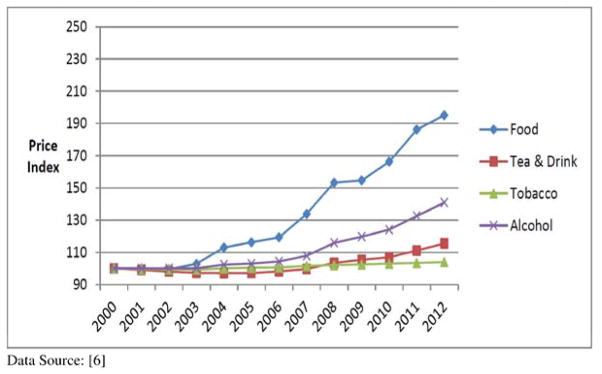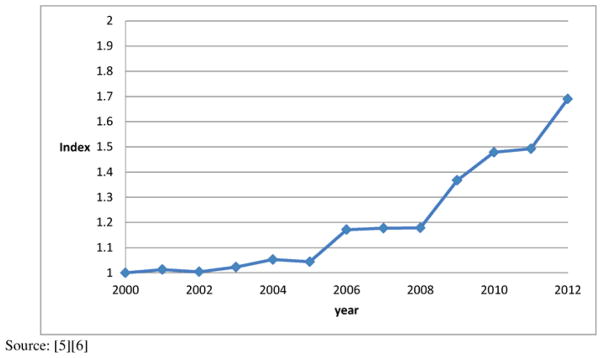I. Introduction
The Chinese government ratified the World Health Organization (WHO) Framework Convention on Tobacco Control (FCTC) in 2005. On May 10, 2015, 10 years after the ratification, the Chinese Ministry of Finance officially raised the tax on cigarettes, and China’s State Tobacco Monopoly Administration (STMA) passed the tax on to cigarette retail prices. This was a significant step for the tobacco control agenda in China. To understand the significance of this policy initiative, it is useful to briefly describe the role of China’s tobacco industry, the cigarette pricing mechanism, and the tobacco tax structure in the Chinese economy.
The Chinese tobacco industry is a government-owned national monopoly, the State Tobacco Monopoly Administration. In 2013, STMA produced more than 2.0 trillion cigarettes, which contributed 816 billion RMB (US $ 130 billion), or about 6.3 percent of China’s central government tax revenue. [1] Because of the importance of the tobacco economy in China, STMA has the advantage of being able to work with the central and local governments. STMA’s goal is to grow the industry, even though the harmful health effects of smoking are now well known in China.
According to the 1983 STMA tobacco monopoly law and regulations, STMA is responsible for the centralized management of cigarette factories, cigarette companies, and retailers, and it determines cigarette prices. Cigarette factories decide cigarette producer prices, cigarette companies decide cigarette wholesale prices( the producer prices and wholesale prices need to be reported and to be approved by State Administration of Taxation), and cigarette retailers decide cigarette retail prices by adding a regulated market profit margin set by the STMA to the wholesale price.
The Chinese government collects five different taxes from the tobacco industry: tobacco leaf tax, value added tax, excise tax, and urban construction/educational supplemental tax. The value added tax (VAT) is not tobacco-specific, but has a uniform rate (17%) across all products. Within these five types of taxes, only the excise tax directly influences the magnitude of the retail price of cigarettes. During all past tobacco tax adjustments in China, the Ministry of Finance focused on the excise tax, which has two tax bases: the producer price and the wholesale price. Within each tax base are two types of taxes: a specific excise tax based on product quantity, and an ad valorem tax based on product price. China does not have an excise tax at the cigarette retail level. Thus, all government tax adjustments occur at either the producer price level and/or the wholesale price level, with either and/or both a specific excise tax and an ad valorem tax.
Before May 10, 2015, the specific excise tax at the producer price level was 0.06 RMB (US $0.01) per pack, and the ad valorem tax was 56% for cigarettes that cost(producer price) 7 RMB (US $ 1.03) or above and 36% for cigarettes costing(producer price) less than 7RMB per pack, as shown in Table 1. A 5% ad valorem tax per pack was levied at the wholesale price level. After May 10, 2015, the Ministry of Finance imposed a specific excise tax of 0.10 RMB (US $ 0.017) per pack at the wholesale level and increased the ad valorem tax at the wholesale price level from 5% to 11%. The STMA announced that these tax increases at the wholesale level would let retailers pass along the increase to the retail prices of cigarettes. Shifting these increased taxes to the retail level, these combined excise tax rate changes will increase the average retail price of cigarettes in China by close to 1 RMB ($0.16) per pack, raising the total share of taxes from 51.02% to 54.82% of the average retail price of cigarettes and representing an average 7.27% increase in the retail price, depending on the estimated price elasticities of the demand for cigarettes, which range between −0.15 and −0.40. The China National Tobacco Company has predicted their sales could be reduced by 2 billion to 2.25 billion packs of cigarettes. [2]
Table I.
Comparison of Chinese Tobacco Excise Tax Structure before and after May 10, 2015
| Before May 10, 2015 | After May 10, 2015 | |
|---|---|---|
| At Producer price level | ||
| Specific excise tax (per pack) | 0.06 RMB | 0.06 RMB |
| Ad valorem tax | ||
| >= 7 RMB | 56% | 56% |
| < 7 RMB | 36% | 36% |
| At Wholesale price level | ||
| Specific excise tax (per pack) | 0 | 0.10 RMB |
| Ad valorem tax | 5% | 11% |
II. Significance
The May 2015 tax increase is welcome news for tobacco control communities. Assuming a 7.27% increase in the retail price, a 40% price elasticity of the demand for cigarettes of −0.15 as quitting elasticity, and 365 million current smokers in 2014, this tax increase would result in about 1.6 million smokers quitting (0.06* 0.0727 * 365 million = 1.6 million). [3] Therefore, this tax increase is a win-win policy for government revenue and population health.
China had already implemented a tobacco tax adjustment in 2009; however, its sole purpose was for the government to raise tax revenue from the STMA. The additional tax was absorbed by tobacco companies rather than passed on to consumers. To maintain the size of the tobacco sales market in China, the tax adjustment in 2009 specifically indicated that STMA would not shift the tax increase to the cigarette retail price. [4] The 2015 tax increase reflects the Chinese government’s commitment, explicitly indicated, to comply with Article 6 of the FCTC, which calls for raising the tobacco tax and shifting the increase to the retail price level.
Unlike the 2009 tax adjustment, China’s recent (2015) tax adjustment has moved the increase from the tax base at the wholesale price level to the retail price level, as shown in Table 1. Since the current Chinese tax system includes no excise tax at the retail level, increasing the excise tax at the wholesale price level rather than at the producer price level brings the STMA one step closer to shifting the tax to the retailer. [4] Furthermore, the Chinese government has adopted a specific excise tax at the wholesale price level, instead of at the producer price level, although the amount of the increase is quite minimal. The WHO Tobacco Tax Administration Manual has suggested that the use of a specific excise tax is more efficient for tax collection and more effective for tobacco control than the use of an ad valorem tax. [5]
The prices of China’s hundreds of cigarette brands range from 1.5 RMB (US $0.25) to more than 100 RMB (US $16.00) per pack. The higher the price brand, the higher the profit margin for the industry. With the tax increase in 2015, the profit for the tobacco industry from the cheapest cigarettes is much less than the profit from the higher priced brands. The ultimate result will be that the cheapest brand group eventually will be eliminated from the market. Raising the price across all brands will increase the overall price of cigarettes by 7.27%, from 11.74RMB per pack to 12.82 RMB per pack. [6]
III. Challenges and the Way Forward
Using a tobacco tax as an instrument for tobacco control is a significant step for the Chinese government. However, the increase in the resulting tax rate as a percentage of the retail price, from 49% to 56%, is still relatively low compared to the WHO-recommended benchmark, which is about 70% of the retail price. Cigarette prices in China have not increased much during the past decade. According to the China National Statistical Yearbook, [1,7] from 2000 to 2012, the price index of cigarettes rose by just 4 percent (year 2000 =100, 2012= 103.9). In contrast, food prices doubled (2000 = 100, 2012 = 195.1), the alcohol price index increased 40 percent (2000=100, 2012 = 140.90), and the price of tea and soft drinks went up 15 percent (2000 = 100, 2012 = 115.5) (see Figure 1). Therefore, the rate of increase of cigarette prices in China is way behind that of many food products.
Figure 1.
Retail prices of tobacco and other foods in China (2000 year as 100)
Furthermore, China made rapid economic growth between 2000 and 2012, with an annual rate of GDP growth of more than 9%. To address the affordability of cigarettes, one can divide per capita income by price per pack of cigarettes each year. Then using the base year (year 2000) rate as a decrement for each subsequent year (e.g., 2000, 2001, 2002, etc.), one can determine an affordability index. As shown in Figure 2, the affordability index of cigarette consumption in China increased from 1.00 in 2000 to 1.69 in 2012, an almost 70% increase in purchasing power.[1,7] In other words, cigarettes in China are now about 70% more affordable than they were in the year 2000. Therefore, ample room remains for the Chinese government to further increase the tax on cigarettes.
Figure 2.
The affordability index of cigarette consumption (2000–2012)
As shown in Table 1, China has a very complicated tobacco excise tax structure. The Ministry of Finance is still undertaking overall excise tax reform. Following the WHO Tobacco Tax Administration guideline, [5] the next round of tobacco tax reform in China hopefully will simplify the country’s tobacco tax structure by (1) raising the specific excise tax at the wholesale price level from 0.1 RMB to 1.00 RMB per pack, and (2) converting the tiered ad valorem tax rates into a uniform tax rate at the producer price level, perhaps raising the tax rate from 36% to 56% for all classes of cigarette products. With these suggested additional tax adjustments, China would be reaching toward the WHO recommended benchmark of close to 70% of the retail price.
Finally, it will be very important to conduct empirical evaluations of the impact of this recent tobacco tax increase on changes in cigarette consumption, smoking behavior, retail cigarette prices, market structure of brand shares, and changes in government revenues. The findings of such analyses would be useful for the next round of tobacco tax policy adjustment in China.
Acknowledgments
The authors are grateful for suggestions and comments provided by three anonymous reviewers. The authors remain responsible for the content of the paper and the views expressed herein do not represent those of the authors’ affiliation.
Funding: This study was funded by the U.S. National Institute of Health, Fogarty International Center and National Cancer Institution of the National Institutes of Health under award number (R01-TW009295), the Bill and Melinda Gates Foundation, and the China National Natural Science Foundation (under award number 71373045).
Footnotes
Contributorship Statement: TH originated the idea for this paper and drafted the manuscript. XZ provided data sources and reviewed and edited the draft. RZ analyzed data and reviewed and edited the draft.
Competing interest: None.
References
- 1.China National Tobacco Company. China Tobacco Statistical Year Book (2000–2014) Beijing, China: [Google Scholar]
- 2.Xu YB. [accessed on 6/16/2015];Another Round of Tobacco Tax Reform, Tobacco Industry Will Face Major Revolution (in Chinese) http://www.yancaotx.com/article-105-1.html.
- 3.Mao Z, Song H, Hu T-w, Yang G. The Demand for Cigarettes in China. Tobacco Control Policy Analysis in China. In: Hu T-w., editor. Economics and Health. World Scientific Publishing; Singapore: 2008. pp. 129–157. [Google Scholar]
- 4.Gao S, Zheng R, Hu TW. Can Increase in the Cigarette Tax Rate be Linked to Cigarette Retail Price? Solving Mysteries Related to the Cigarette Pricing Mechanism in China. Tob Control. 2012;21:560–562. doi: 10.1136/tobaccocontrol-2011-050027. [DOI] [PMC free article] [PubMed] [Google Scholar]
- 5.World Health Organization. WHO Technical Manual on Tobacco Tax Administration. Geneva, Switzerland: 2010. [Google Scholar]
- 6.Zheng R. Potential Impact of 2015 Cigarette Tax Adjustment: preliminary evaluation results. presented at WHO/Beijing Health Dialogue; May 11, 2015. [Google Scholar]
- 7.China National Bureau of Statistics. China National Statistical Yearbook, 2000–2014. Beijing, China: [Google Scholar]




